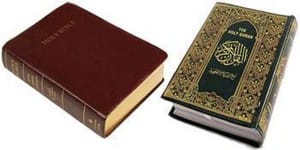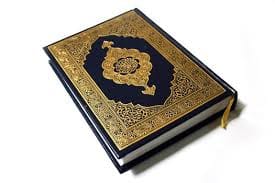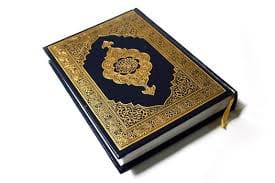QURAN & BIBLE STRUCTURE

Here is a detailed breakdown of the format of the Quran in 100 points:
- The Quran consists of 114 chapters (Surahs).
- It is divided into 30 sections (Juz’/Para) for easy recitation.
- The Quran is written in classical Arabic.
- Each Surah is made up of verses (Ayat), totaling 6,236 (excluding Bismillah) or 6,349 (including it every time it appears).
- The chapters vary in length, with Surah Al-Baqarah (286 verses) being the longest and Surah Al-Kawthar (3 verses) the shortest.
- The Quran is traditionally written in Uthmani script.
- It is recited and memorized in Arabic, even by non-Arabic speakers.
- The Quran is not in chronological order but arranged by divine command.
- The first revelation was Surah Al-‘Alaq (96:1-5).
- The last revelation is believed to be Surah Al-Ma’idah (5:3) or Surah An-Nasr (110).
- Surahs are arranged approximately longest to shortest, except for Surah Al-Fatiha, which comes first.
- The chapters are categorized into Makki (revealed in Makkah) and Madani (revealed in Madinah).
- There are 86 Makki Surahs and 28 Madani Surahs.
- The Quran begins with Surah Al-Fatiha (The Opening).
- The last chapter is Surah An-Nas (The Mankind).
- Almost every Surah begins with Bismillah (In the name of Allah, the Most Gracious, the Most Merciful) except Surah At-Tawbah (9).
- Surah An-Naml (27:30) includes Bismillah within the text, making its total count 114.
- The Quran is poetic yet not poetry.
- It uses rhymed prose (Saj’).
- It has varied sentence structures for emphasis.
- It employs repetition for reinforcement.
- Many verses begin with vocatives (O you who believe, O mankind, etc.).
- It includes parables, metaphors, and similes.
- The Quran is self-referential, often stating, "This is a revelation from Allah."
- It frequently uses oaths (By the Sun, By the Moon, etc.).
- The Quran addresses mankind, believers, disbelievers, and hypocrites separately.
- The Quran covers Tawheed (Oneness of Allah).
- It speaks of Prophethood.
- It details the Hereafter.
- The Quran contains legal rulings (Ahkam).
- It narrates stories of previous Prophets.
- It describes Heaven and Hell.
- It contains scientific facts.
- The Quran discusses Jihad (struggle in Allah’s cause).
- It has economic, social, and ethical guidelines.
- There are commands and prohibitions.
- The Quran uses divine attributes of Allah frequently.
- Some Surahs start with mysterious letters (Muqatta’at) like Alif-Lam-Mim.
- There are 29 Surahs with Muqatta’at.
- The Quran calls itself Al-Furqan (The Criterion).
- It refers to itself as Dhikr (The Reminder).
- It is called Nur (Light).
- The Quran is protected from corruption (15:9).
- It challenges mankind to produce a chapter like it (2:23).
- The Quran contains unmatched eloquence.
- The Quran was revealed gradually over 23 years.
- It was preserved orally and in writing.
- The first compilation was under Abu Bakr (RA).
- The official version was standardized under Uthman (RA).
- It is memorized (Hifz) by millions worldwide.
- The Quran has been preserved in its original language.
- There are Qira’at (recitation styles).
- The 10 major Qira’at are traced back to the Prophet Muhammad (PBUH).
- The most common Qira’a is Hafs 'an Asim.
- It is recited using Tajweed (proper pronunciation rules).
- The Quran is explained by Hadiths of the Prophet (PBUH).
- Tafsir is a science dedicated to explaining the meanings of verses.
- Classical Tafsir works include Tafsir Ibn Kathir.
- Tafsir can be linguistic, thematic, or historical.
- Scholars use Arabic grammar, history, and Hadith to explain it.
- Some verses are clear (Muhkam), while others are ambiguous (Mutashabih).
- The Quran claims linguistic inimitability.
- It has scientific accuracy ahead of its time.
- It contains historical facts unknown at the time.
- It has no contradictions.
- It remains unchanged for over 1400 years.
- The Quran is recited with respect (not while impure).
- It follows Tajweed rules.
- The Quran is often written with diacritical marks (Tashkeel).
- It is decorated with calligraphy.
- The Quran has shaped Islamic law (Shariah).
- It influences daily Muslim prayers.
- The Quran promotes justice and morality.
- It encourages seeking knowledge.
- It is a source of healing (Shifa).
- It is recited in Salah (prayer).
- Muslims recite it daily.
- It is used in legal judgments.
- It influences Islamic architecture and art.
- It is memorized in Madrasas worldwide.
- The Quran is available in printed Mushaf form.
- It is available in digital formats.
- It is translated into 100+ languages, though translations are not considered the Quran itself.
- It is often written in gold and decorated manuscripts.
- Special Madani Mushaf has unique recitation stops (Ruku’ signs).
- Muslims seek blessings (Barakah) from reading it.
- It is recited at funerals and special occasions.
- It is respected (not placed on the ground, etc.).
- It is often memorized from childhood.
- Some wear amulets with Quranic verses.
- It is recited in Ramadan (Taraweeh prayers).
- The Quran promises divine guidance (2:2).
- It is a mercy for believers (17:82).
- It is a proof against those who reject it (25:30).
- It will be intercessor on Judgment Day.
- Allah commands pondering upon its verses (47:24).
- It is the greatest miracle of Prophet Muhammad (PBUH).
- It is timeless and universal.
- It has been unchanged for 14 centuries.
- The Quran is the Final Revelation of Allah.
Here’s a detailed breakdown of the format of the Old Testament (Hebrew Bible / Tanakh) in 100 points:
- The Old Testament is the first part of the Christian Bible and the entire Hebrew Bible for Jews.
- It consists of 39 books (Christian arrangement) or 24 books (Jewish arrangement).
- It is written primarily in Hebrew, with some portions in Aramaic (e.g., Daniel 2-7, parts of Ezra).
- The Jewish arrangement is called Tanakh, an acronym for Torah (Law), Nevi’im (Prophets), and Ketuvim (Writings).
- The Christian Old Testament is arranged differently, following the Septuagint (Greek translation) order.
- The Old Testament is divinely inspired and considered sacred by Jews and Christians.
- It was written over a span of 1,000+ years, from around 1400 BCE to 400 BCE.
- Torah (Pentateuch): 5 Books (Genesis, Exodus, Leviticus, Numbers, Deuteronomy).
- Nevi’im (Prophets): 8 Books (Includes Joshua, Judges, Samuel, Kings, Isaiah, Jeremiah, Ezekiel, and the Twelve Minor Prophets counted as one book).
- Ketuvim (Writings): 11 Books (Includes Psalms, Proverbs, Job, and others).
- The Pentateuch (5 books): Genesis, Exodus, Leviticus, Numbers, Deuteronomy.
- Historical Books (12 books): Joshua, Judges, Ruth, 1 & 2 Samuel, 1 & 2 Kings, 1 & 2 Chronicles, Ezra, Nehemiah, Esther.
- Wisdom Books (5 books): Job, Psalms, Proverbs, Ecclesiastes, Song of Solomon.
- Major Prophets (5 books): Isaiah, Jeremiah, Lamentations, Ezekiel, Daniel.
- Minor Prophets (12 books): Hosea to Malachi.
- Most of the Old Testament is in Biblical Hebrew.
- Portions are in Biblical Aramaic (Daniel 2-7, Ezra 4-7, Jeremiah 10:11).
- The oldest complete Hebrew manuscript is the Aleppo Codex (10th century CE).
- The Dead Sea Scrolls (3rd century BCE - 1st century CE) contain the oldest partial manuscripts.
- The Masoretic Text (MT) is the standardized Hebrew text used today.
- The Septuagint (LXX) is the Greek translation made in the 3rd–2nd century BCE.
- The Samaritan Pentateuch preserves an alternate version of the first five books.
- The Old Testament emphasizes monotheism (belief in one God – Yahweh/Allah).
- It covers creation, sin, covenants, law, prophecy, and redemption.
- It tells the story of Adam, Noah, Abraham, Moses, David, Solomon, and the Prophets.
- It includes moral, ceremonial, and civil laws for Israel.
- It predicts the coming of a future Messiah (interpreted differently by Jews and Christians).
- It covers God’s covenant with Israel and their history.
- The books are written in historical narrative, poetry, prophecy, and law.
- It contains Psalms and prayers (Psalms, Lamentations).
- It includes wisdom literature (Proverbs, Ecclesiastes, Job).
- The events take place in the Middle East, primarily Canaan, Egypt, and Mesopotamia.
- The timeline spans from Creation to about 400 BCE.
- It documents the formation of Israel as a nation.
- It records the Babylonian exile (586 BCE).
- It includes historical records of kings, wars, and laws.
- The Ten Commandments are found in Exodus 20 and Deuteronomy 5.
- Levitical laws govern purity, sacrifices, and worship.
- It contains extensive genealogies.
- Many passages are repetitive for emphasis.
- Parallel accounts exist (e.g., 1 & 2 Kings vs. 1 & 2 Chronicles).
- Some books have acrostic poetry (e.g., Psalms, Lamentations).
- Many books are anonymous (authorship unknown).
- The Jewish canon was finalized around 90 CE at the Council of Yavne.
- The Septuagint includes extra books (Apocrypha), later removed by Protestants.
- The Catholic Old Testament has 46 books (includes Tobit, Judith, Wisdom, Sirach, Baruch, and Maccabees).
- The Eastern Orthodox Old Testament includes even more books.
- The Protestant Old Testament has 39 books, removing the Apocrypha.
- The Ethiopian Orthodox Church includes Enoch and Jubilees.
- The Old Testament predicts a coming Messiah (Isaiah 53, Daniel 9, Micah 5:2).
- Some see Jesus as the fulfillment, while Jews await a future Messiah.
- It foretells the restoration of Israel.
- Many prophecies were fulfilled in historical events.
- The Noahic Covenant applies to all mankind.
- The Abrahamic Covenant promises a great nation.
- The Mosaic Covenant gives the Law.
- The Davidic Covenant promises an eternal kingdom.
- The Old Testament lays ethical and religious laws.
- The Old Testament influenced Judaism, Christianity, and Islam.
- It has been preserved by scribes (Masoretes).
- It has been translated into hundreds of languages.
- It is part of daily prayers in Judaism and Christianity.
- The Old Testament includes narratives (Genesis, Kings, Chronicles).
- It has poetry (Psalms, Song of Solomon, Lamentations).
- It contains prophetic writings (Isaiah, Jeremiah, Ezekiel, etc.).
- There are laws (Exodus, Leviticus, Deuteronomy).
- There are wisdom sayings (Proverbs, Ecclesiastes, Job).
- Jews read the Torah in a yearly cycle.
- Christians read the Old Testament alongside the New Testament.
- It is studied in synagogues, churches, and universities.
- It has commentaries (Midrash, Talmud, Church Fathers).
- The Passover Lamb (Exodus 12) foreshadows sacrifice.
- The Temple (1 Kings 6) symbolizes divine presence.
- The ark (Genesis 6-9) symbolizes salvation.
- Major Prophets: Isaiah, Jeremiah, Ezekiel, Daniel.
- Minor Prophets: Hosea to Malachi.
- The Prophets call for justice, repentance, and faithfulness.
- Christians see it as fulfilled in the New Testament.
- Islam acknowledges it as partially divine but altered.
- Muslims believe the Torah (Tawrat) was originally revealed to Musa (Moses).
- The Old Testament is a historical, legal, and religious document.
- It remains one of the most studied texts in history.
- It is central to Jewish identity.
- It is referenced extensively in Christian theology.
- It is quoted in the Quran.
- The Psalms are still recited in worship.
- It influenced Western literature and philosophy.
- It continues to be debated and analyzed.
- It has been preserved remarkably over centuries.
It remains one of the most influential religious texts of all time.
Here’s a detailed breakdown of the New Testament in 100 points:
- The New Testament is the second part of the Christian Bible.
- It consists of 27 books.
- It is written primarily in Koine Greek.
- It was written between circa 50 CE – 100 CE.
- It focuses on the life, teachings, death, and resurrection of Jesus (ʿĪsā in Islam).
- It includes Gospels, history, epistles (letters), and prophecy.
- It is considered divinely inspired by Christians.
- It is not part of the Jewish Tanakh.
- It is accepted by all Christian denominations.
- The earliest manuscripts are fragments from the 2nd century CE.
- The Gospels (4 books): Matthew, Mark, Luke, John.
- Historical Book (1 book): Acts of the Apostles.
- Pauline Epistles (13 books): Romans, Corinthians, Galatians, etc.
- General Epistles (8 books): Hebrews, James, Peter, John, Jude.
- Prophetic Book (1 book): Revelation.
- Originally written in Koine Greek.
- Some Aramaic phrases remain (e.g., "Eli Eli lama sabachthani").
- The Codex Sinaiticus (4th century CE) is one of the oldest complete manuscripts.
- The Codex Vaticanus is another early complete manuscript.
- The Papyrus P52 (c. 125 CE) is the earliest known fragment (John 18).
- The Textus Receptus was used for the King James Bible.
- The Nestle-Aland Greek New Testament is the standard critical text today.
- The Kingdom of God is a major theme.
- Emphasizes love, grace, salvation, and faith.
- Centers on Jesus as the Messiah (Al-Masih).
- Includes teachings on prayer, forgiveness, and humility.
- Prophecies about end times and second coming.
- Parables are a major teaching method.
- Focuses on Jesus' crucifixion and resurrection.
- Takes place in 1st-century Roman-occupied Palestine.
- Jesus' ministry lasted about 3 years.
- Includes historical figures like Herod, Pilate, and Caesar.
- The early church formed under Roman persecution.
- The apostles spread Christianity to the Roman Empire and beyond.
- The destruction of the Second Temple (70 CE) affected Jewish-Christian relations.
- Four Gospel accounts provide different perspectives.
- Paul’s letters are written to churches and individuals.
- Acts of the Apostles records the early church’s history.
- Revelation uses apocalyptic imagery.
- Some passages are repeated in multiple books.
- Contains Old Testament quotations.
- The New Testament canon was finalized around 4th century CE.
- The Council of Carthage (397 CE) affirmed the 27 books.
- The Catholic Church includes the same 27 books.
- The Orthodox Church accepts additional traditions.
- Some early Christians used Gnostic gospels, which were later rejected.
- The King James Version (1611 CE) popularized the English Bible.
- Claims Jesus fulfills Old Testament prophecies.
- Isaiah 53 is often linked to Jesus.
- Micah 5:2 is seen as predicting Jesus’ birthplace (Bethlehem).
- Zechariah 9:9 is linked to Jesus’ entry into Jerusalem.
- Salvation by faith is a key teaching.
- Love your neighbor is central.
- The Lord’s Prayer is a model prayer (Matthew 6:9-13).
- The Sermon on the Mount (Matthew 5-7) includes the Beatitudes.
- Baptism and communion are key Christian rituals.
- Jesus’ birth (Matthew & Luke).
- Jesus’ baptism by John the Baptist.
- Miracles (healing the sick, feeding the 5,000).
- Last Supper with the disciples.
- Crucifixion under Pontius Pilate.
- Resurrection on the third day.
- Ascension to heaven.
- Pentecost (Acts 2) – the Holy Spirit descends.
- Jesus’ 12 disciples include Peter, John, and Judas.
- Paul (formerly Saul) was a major missionary.
- Mary, the mother of Jesus, plays an important role.
- John the Baptist prepared the way for Jesus.
- Forgive others (Matthew 6:14).
- Help the poor (Matthew 25:35-40).
- Turn the other cheek (Matthew 5:39).
- Judge not, lest you be judged (Matthew 7:1).
- Jesus as the Lamb of God (John 1:29).
- The Good Shepherd (John 10:11).
- The Bread of Life (John 6:35).
- Early Christians met in homes, not churches.
- Sunday became the main day of worship.
- Baptism and the Eucharist were central practices.
- The New Testament has been translated into over 3,000 languages.
- It is the most widely printed book in history.
- It has influenced Western law, ethics, and culture.
- The Gospels are biographies.
- The Epistles are letters.
- Revelation is apocalyptic literature.
- Protestants emphasize sola scriptura (Scripture alone).
- Catholics include church tradition and papal authority.
- Orthodox Christianity keeps mystical interpretations.
- The New Testament builds on the Old Testament.
- Islam sees Jesus (ʿĪsā) as a Prophet but not divine.
- The Quran references Jesus’ miracles and virgin birth.
- Jesus predicts the destruction of the Temple (Matthew 24:2).
- The Book of Revelation describes the end of the world.
- The Antichrist and Judgment Day are major themes.
- It is a religious, historical, and moral document.
- It remains one of the most studied texts in history.
- It is central to Christian identity.
- It continues to be translated, debated, and analyzed.
- It is quoted in philosophy, law, and literature.
- It has shaped art, music, and culture.
- It remains one of the most influential religious texts of all time.
Feel free to leave me a comment at the email below.
Email: myimanonline@gmail.com
Should you wish to help me accomplish this mission of creating comparative study in full, please donate for the cause.


